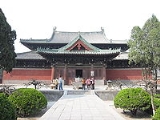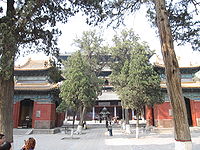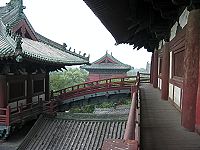
Longxing Monastery
Encyclopedia
The Longxing Monastery or Longxing Temple is an ancient Buddhist
monastery
located near the town of Zhengding
in Hebei
Province, China
, approximately 15 kilometers north of the provincial capital of Shijiazhuang
. It has been referred to as the "First Temple south of Beijing".
 The monastery was first built in 586 AD, during the Sui Dynasty
The monastery was first built in 586 AD, during the Sui Dynasty
. Its original name was Longcang monastery . One of the oldest stelae on the grounds of the monastery, the "Longcangsi Stele" , dates from the year the monastery's foundation. Much of it was reconstructed during the Song Dynasty
(960-1279 AD).
Following a common pattern, the monastery complex features a central axis along which a sequence of buildings and focal points is arranged. The first building is the Hall of the Heavenly Kings
. At the opposite end of the axis is the Main Hall , a 33-meter-high wooden structure, which houses a bronze statue of Guan Yin
. This bronze was built during the early years of the Song Dynasty
; its height exceeds 20 meters. Inside the hall, a staircase leads around the statue which allows it to be seen from top to bottom.
 Other notable artworks of the monastery are a colorful wooden carving of Guanyin sitting in a grotto and statues of Buddha
Other notable artworks of the monastery are a colorful wooden carving of Guanyin sitting in a grotto and statues of Buddha
sitting on a lotus
throne.
A unique piece of wood architecture from the Song Dynasty in the Longxing Monastery is the Pavilion of the Rotating Library, which was restored in the 20th century. The pavilion houses a rotating bookshelf which was formerly used to store holy texts and Buddhist sutra
s. This rotating book case repository
dates back to the 12th century, and is the oldest existent rotating repository of its kind (refer to the article Technology of the Song Dynasty
).
Today, the Longxing Monastery is open to the public as a museum
.
Buddhism
Buddhism is a religion and philosophy encompassing a variety of traditions, beliefs and practices, largely based on teachings attributed to Siddhartha Gautama, commonly known as the Buddha . The Buddha lived and taught in the northeastern Indian subcontinent some time between the 6th and 4th...
monastery
Monastery
Monastery denotes the building, or complex of buildings, that houses a room reserved for prayer as well as the domestic quarters and workplace of monastics, whether monks or nuns, and whether living in community or alone .Monasteries may vary greatly in size – a small dwelling accommodating only...
located near the town of Zhengding
Zhengding
Zhengding is a county in Hebei Province approximately 260 kilometers south of Beijing, China. It comes under the administration of nearby Shijiazhuang City and has a population of 594,000. Zhengding has been an important religious center for more than 1,000 years, from - at least - the times...
in Hebei
Hebei
' is a province of the People's Republic of China in the North China region. Its one-character abbreviation is "" , named after Ji Province, a Han Dynasty province that included what is now southern Hebei...
Province, China
China
Chinese civilization may refer to:* China for more general discussion of the country.* Chinese culture* Greater China, the transnational community of ethnic Chinese.* History of China* Sinosphere, the area historically affected by Chinese culture...
, approximately 15 kilometers north of the provincial capital of Shijiazhuang
Shijiazhuang
Shijiazhuang is the capital and largest city of North China's Hebei province. Administratively a prefecture-level city, it is about south of Beijing...
. It has been referred to as the "First Temple south of Beijing".
History

Sui Dynasty
The Sui Dynasty was a powerful, but short-lived Imperial Chinese dynasty. Preceded by the Southern and Northern Dynasties, it ended nearly four centuries of division between rival regimes. It was followed by the Tang Dynasty....
. Its original name was Longcang monastery . One of the oldest stelae on the grounds of the monastery, the "Longcangsi Stele" , dates from the year the monastery's foundation. Much of it was reconstructed during the Song Dynasty
Song Dynasty
The Song Dynasty was a ruling dynasty in China between 960 and 1279; it succeeded the Five Dynasties and Ten Kingdoms Period, and was followed by the Yuan Dynasty. It was the first government in world history to issue banknotes or paper money, and the first Chinese government to establish a...
(960-1279 AD).
Following a common pattern, the monastery complex features a central axis along which a sequence of buildings and focal points is arranged. The first building is the Hall of the Heavenly Kings
Four Heavenly Kings
In the Buddhist faith, the Four Heavenly Kings are four gods, each of whom watches over one cardinal direction of the world.The Kings are collectively named as follows:...
. At the opposite end of the axis is the Main Hall , a 33-meter-high wooden structure, which houses a bronze statue of Guan Yin
Kuan Yin
Guanyin is the bodhisattva associated with compassion as venerated by East Asian Buddhists, usually as a female. The name Guanyin is short for Guanshiyin which means "Observing the Sounds of the World". She is also sometimes referred to as Guanyin Pusa...
. This bronze was built during the early years of the Song Dynasty
Song Dynasty
The Song Dynasty was a ruling dynasty in China between 960 and 1279; it succeeded the Five Dynasties and Ten Kingdoms Period, and was followed by the Yuan Dynasty. It was the first government in world history to issue banknotes or paper money, and the first Chinese government to establish a...
; its height exceeds 20 meters. Inside the hall, a staircase leads around the statue which allows it to be seen from top to bottom.

Gautama Buddha
Siddhārtha Gautama was a spiritual teacher from the Indian subcontinent, on whose teachings Buddhism was founded. In most Buddhist traditions, he is regarded as the Supreme Buddha Siddhārtha Gautama (Sanskrit: सिद्धार्थ गौतम; Pali: Siddhattha Gotama) was a spiritual teacher from the Indian...
sitting on a lotus
Nelumbo nucifera
Nelumbo nucifera, known by a number of names including Indian Lotus, Sacred Lotus, Bean of India, or simply Lotus, is a plant in the monogeneric family Nelumbonaceae...
throne.
A unique piece of wood architecture from the Song Dynasty in the Longxing Monastery is the Pavilion of the Rotating Library, which was restored in the 20th century. The pavilion houses a rotating bookshelf which was formerly used to store holy texts and Buddhist sutra
Sutra
Sūtra is an aphorism or a collection of such aphorisms in the form of a manual. Literally it means a thread or line that holds things together and is derived from the verbal root siv-, meaning to sew , as does the medical term...
s. This rotating book case repository
Repository (publishing)
A repository in publishing, and especially in academic publishing,is a real or virtual facility for the deposit of academic publications, such as academic journal articles....
dates back to the 12th century, and is the oldest existent rotating repository of its kind (refer to the article Technology of the Song Dynasty
Technology of the Song Dynasty
The Song Dynasty provided some of the most significant technological advances in Chinese history, many of which came from talented statesmen drafted by the government through imperial examinations....
).
Today, the Longxing Monastery is open to the public as a museum
Museums in China
As of 2006, there are more than 2,200 museums in China, which includes public museums and museums of universities. Local non-governmental museums included, the number of museums nationwide has reached some 2,900. With a collection of over 20 million items, these museums hold more than 8,000...
.
See also
- List of Buddhist temples
- Chinese Buddhism

